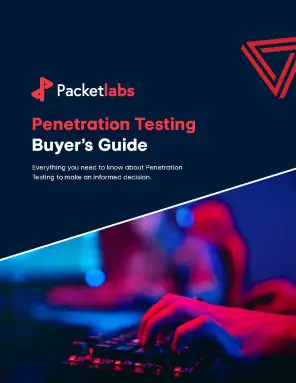Threats
Corporate Mutiny Cybersecurity Risks and How to Handle Them
Would you like to learn more?
Download our Guide to Penetration Testing to learn everything you need to know to successfully plan, scope and execute your penetration testing projects
As cyber threats continue to rise, businesses must recognize that the risks don’t always come from external sources. In fact, threats originating from within the organization can be just as harmful, if not more so. 83% of organizations reported having at least one insider attack in the past year according to Cybersecurity Insiders’ 2024 Insider Threat Report. Even more alarming, the number of organizations facing between 11-20 insider attacks per year has surged fivefold, jumping from just 4% to 21% in 2024. 48% of respondents indicated that insider threats have become a much bigger concern in the last 12 months. In terms of financial costs, 32% of companies reported recovery costs in the range of $100,000 to $499,000, while 21% reported steeper costs, ranging from $1 million to $2 million.
Insider threats can come from foreign interference and espionage, but corporate mutiny can also emerge organically from within an organization creating significant cybersecurity threats operating directly within the ranks of an organization.
Let's explore what experts say about the cause and effects of corporate mutiny. By acknowledging that corporate mutiny is a viable threat and understanding what causes it, leaders can build programs to detect it and remediate its causes.
Corporate Mutiny Cybersecurity Implications
When corporate cybersecurity mutiny occurs, the impact goes beyond just organizational morale—it can have serious cybersecurity consequences. Understanding the potential risks that come with discontent among employees is key to staying ahead of threats and protecting your organization.
Operational Sabotage: Disgruntled IT administrators or employees could plant malicious code that activates long after their departure. These attacks can cripple systems, causing delays, financial losses, or data breaches. But, mutinous employees can also disrupt critical business operations while remaining employed at the company, claiming human error. For example, altering configurations, deleting key files, or shutting down essential services, resulting in downtime and significant recovery costs.
Knowledge Silos and Power Plays: Concentrated knowledge within small groups can result in an imbalance of power. If these groups form coalitions, they can disrupt operations by withholding critical information or taking proprietary knowledge with them when they leave.
Shadow IT and Security Workarounds: Employees bypassing established security protocols to maintain productivity often create unmonitored systems or applications. These unvetted tools increase an organization’s attack surface and complicate incident response.
Leaking Sensitive Data: Employees involved in mutiny may intentionally leak sensitive information to competitors, media outlets, or cybercriminals. This not only damages the organization's reputation but can also lead to legal and compliance violations. Developers or insiders might intentionally expose sensitive credentials in public forums, such as GitHub repositories or file-sharing services. This can provide attackers with direct access to critical systems and data.
Transferring Digital Assets Outside of the Company: Mutinous employees may transfer control of domain names, proprietary software, or cloud assets outside the organization, leaving the company vulnerable to operational disruptions or extortion attempts.
Disregard of Employee Awareness Programs: Specifically cyber-related, employees disengaged with the company may disregard the completion or takeaways from assigned Employee Awareness Programs and related trainings, thereby putting the organization at higher cybersecurity risk.
What Do Management Experts Say About Corporate Mutiny?
According to Harvard, corporate mutinies are justified when leadership is destructive, shared values are violated, and the situation becomes intolerable for those affected. Furthermore, mutinies can succeed when leadership is either technically weak but well-liked or technically brilliant but disliked, when shared values are flouted, or when strong ringleaders coordinate mutiny effectively. Supporting research from the Kellstadt Graduate School of Business found that cybersecurity mutiny in organizations is derived from three foundations: disconnections between authority echelons, modes of addressing member disgruntlement, and the need for management to develop continuous competencies.
The Walmart Global Tech Blog identifies four key toxic patterns—unhealthy competition, siloed development, and the tendency to rebuild rather than reuse existing solutions—all of which stem from poor communication, misalignment, and a lack of teamwork. The author, Claude Jones, argues that addressing these inefficiencies requires recognizing and challenging these behaviors to foster a collaborative and productive workplace, ultimately benefiting employees, teams, and customers.
In Dealing With Workplace Rebellion (2021), Adams Oriema highlights that while workplace rebels often challenge authority and tradition, they can be valuable assets due to their confidence, creativity, and innovative mindset. To effectively manage rebels, Oriema suggests strategies such as understanding their motivations, encouraging them to think critically and present well-thought-out ideas, accommodating their independence without relinquishing performance expectations, and reminding them of their role within the team. By leveraging their strengths and fostering collaboration, managers can transform workplace rebels into agents of positive change.
How Can Organizations Detect When Corporate Mutiny is Brewing?
Survindar Chahal identifies several broad categories of signs that corporate mutiny may be brewing within an organization: communication breakdowns (e.g., secretive whispers and gossip), employee disengagement (evidenced by absenteeism, incomplete work, and declining competency), visible preparations for departure (like dressing for job interviews), and rising workplace tension (manifesting through heightened stress and dissatisfaction). Recognizing and addressing these signs early is critical to preventing a mass exodus and restoring harmony within the team.
Corporate mutiny is a predictable outcome of prolonged employee strain; employees grow disillusioned when promises of relief or rewards fail to materialize, leading to burnout, absenteeism, workplace tensions, and ultimately, turnover. Managers should take a proactive approach to engage with employees, understand their concerns, and recognize early signs of discontent to prevent rebellion and foster a fairer, healthier workplace culture.
How to Prevent Corporate Mutiny From Imposing Cyber Risk
Preventing corporate mutiny is largely about fostering a healthy, transparent, and supportive work environment that addresses employee concerns before they escalate into larger issues. Here are several key strategies to help mitigate the risk of mutiny within your organization:
Conduct Streamlined Offboarding: When an employee leaves the organization or is terminated, ensure that all passwords and access credentials are changed promptly. Timely offboarding helps mitigate the risk of retaliation or unauthorized access, reducing the potential for post-departure sabotage.
Conduct Surveys to Monitor Staff Sentiment: Regular surveys provide employees with an anonymous platform to express concerns, suggestions, and dissatisfaction. This allows management to identify brewing issues and address them before they snowball into larger problems.
Build Separation of Duties in IT Teams: To avoid too much power concentrated in one person or group, implement strict separation of duties. This ensures that no single individual can control critical processes or systems, reducing the risk of malicious actions.
Monitor for Shadow IT: Shadow IT can introduce unvetted, unsecured technologies into your company’s ecosystem. Proactively monitor for unauthorized tools or applications that employees may use outside of official channels, as they can be exploited by those seeking to undermine security or operations.
Streamline Communication and Workflow: Clear communication is crucial to avoid misunderstandings that can fuel discontent. Regular meetings, updates, and transparent decision-making processes help employees feel informed and included in the organizational goals.
Monitor Policy Implementations: Ensure that security and operational policies are consistently enforced across all levels of the organization. Actively monitor for attempts to circumvent these policies, which could indicate disgruntlement or intentional non-compliance.
Have Employees Sign Non-Disclosure Agreements (NDAs): NDAs offer legal leverage in cases where confidential or critical information is leaked. By classifying organizational data using Traffic Light Protocol (TLP), you can enhance the NDA’s protection, providing clarity on the sensitivity of specific information and the consequences of its exposure.
Conclusion
This article explores the rising threat of corporate mutiny within organizations, emphasizing its cybersecurity implications and potential risks. It outlines how insider threats, such as operational sabotage, credential exposure, and data leaks, can severely impact an organization.
Management experts weigh in on the causes and effects of mutiny, highlighting leadership failures and toxic organizational patterns. The article also provides guidance on recognizing early signs of mutiny, such as communication breakdowns, disengagement, and rising tensions, offering strategies to address these issues before they escalate into widespread disruption.
Let's Connect
Share your details, and a member of our team will be in touch soon.
Interested in Pentesting?

Penetration Testing Methodology
Our Penetration Security Testing methodology is derived from the SANS Pentest Methodology, the MITRE ATT&CK framework, and the NIST SP800-115 to uncover security gaps.
Download Methodology
Penetration Testing Buyer's Guide
Download our buyer’s guide to learn everything you need to know to successfully plan, scope and execute your penetration testing projects.
Download GuideExplore in-depth resources from our ethical hackers to assist you and your team’s cyber-related decisions.

September 13 - Blog
Why Multi-Factor Authentication is Not Enough
Knowing is half the battle, and the use and abuse of common frameworks shed insight into what defenders need to do to build defense in depth.

November 19 - Blog
The Top Cybersecurity Statistics for 2024
The top cybersecurity statistics for 2024 can help inform your organization's security strategies for 2025 and beyond. Learn more today.

October 24 - Blog
Packetlabs at SecTor 2024
Packetlabs is thrilled to have been a part of SecTor 2024. Learn more about our top takeaway's from this year's Black Hat event.

- Toronto | HQ
- 401 Bay Street, Suite 1600
- Toronto, Ontario, Canada
- M5H 2Y4
- San Francisco | HQ
- 580 California Street, 12th floor
- San Francisco, CA, USA
- 94104
© 2024 Packetlabs. All rights reserved.






